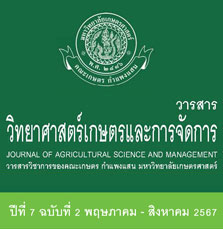Growth and Yield of Over-year Oil Palm Seedling in Krabi Province, Thailand
Keywords:
Elaeis guineensis, FFB, hybrid, large field plot, over-year seedlingAbstract
Performance of normal and over-year oil palm seedlings, in terms of the growth traits and yield production, was evaluated using three replications of a split plot in a randomized complete block design. The main plot was comprised of two types of oil palm seedling (normal and over-year), while the subplot contained seven different oil palm hybrids. Growth characteristics was recorded every 6 months from 12 to 60 months after transplanting (MAT), while the yield data was recorded from 31 to 66 MAT. All of the vegetative growth traits showed no significant difference between normal and over-year seedlings. During the first two years of harvesting, there was no significant difference in the fresh fruit bunch (FFB) production between normal and over-year seedlings. However, in the third year of harvesting, normal seedlings showed a significantly higher FFB than over-year seedlings, with yields of 163 and 145 kg/palm, respectively. The bunch number showed no significant difference between the two types of oil palm seedling. The Thai oil palm cultivars (Deli × Yangambi-T and Deli × Tanzania-T hybrids) had the highest 3-year accumulated FFB yield at 326 and 330 kg/palm, respectively. These results suggest that the hybrid oil palm cultivars bred and developed by the Thai companies can produce a FFB yield as high as the imported cultivars
References
Agusta, H., B. Pratanu, J.F.Saragih, G.C. Handoyo and E Sulistiyono. 2020. The dynamics of precipitation and its relation to flowering status and oil palm productivity. 1st International Conference on Sustainable Plantation. Earth and Environmental Science 418, doi:10.1088/1755-1315/418/1/012043.
Barcelos, E., S. D. A. Rios, R. N. Cunha, R., Lopes, S. Y. Motoike, E. Babiychuk, A. Skirycz and S. Kushnir. 2015. Oil palm natural diversity and the potential for yield improvement. Frontiers in Plant Science 6:190.
Beaton, J.D., M. Hasegawa and J.C.W. Keng. 1990. Some aspects of plant nutrition/soil fertility management to consider in maximum yield research, pp. 131-152. In: Proceedings symposium maximum yield research satellite symposium. 14th International Congress of Soil Science, held at Kyoto, Japan.
Corley, R.H.V. and C.J. Breure. 1988. Measurement in Oil Palm Experiment. UNIPALMOL Company, Malaysia. (Mimeographed). 64 p.
Corley, R.H.V. and P.B Tinker. 2003. The Oil Palm. 4th ed. Blackwell Science, Oxford. 562 p.
Corley, R.H.V. and P.B Tinker. 2016. The Oil Palm. 5th ed. John Wiley and Sons, New York. 647 p.
Rajanaidu, N., M. M., Ainul, A., Kushairi and A. Mohd Din. 2013. Historical review of oil palm breeding for the past 50 years—Malaysian journey. Pp. 11-28. In: Proceedings of the International Seminar on oil Palm Breeding Yesterday, Today and Tomorrow, Kuala Lumpur, Malaysia.
Rethinam, P., K. Suresh, V.M. Reddy, P.C. Tripathi, S. Nair and M. Sugunamani. 2000. Effect of age of oil palm seedlings at planting on growth. Journal of Oil Palm Research 1(1/2): 61-63.
Statista. 2022. Palm oil consumption worldwide from 2015/2016 to 2022/2023. Available Source: https://www.statista.com/statistics/274127/world-palm-oil-usage-distribution/ (June 7, 2023).
Tabatabaei, S.A., V. Rafiee and E. Shakeri. 2012. Comparison of morphological, physiological and yield of local and improved cultivars of cotton in Yazd province. International Journal of Agronomy and Plant Production 3 (5): 164-167.






